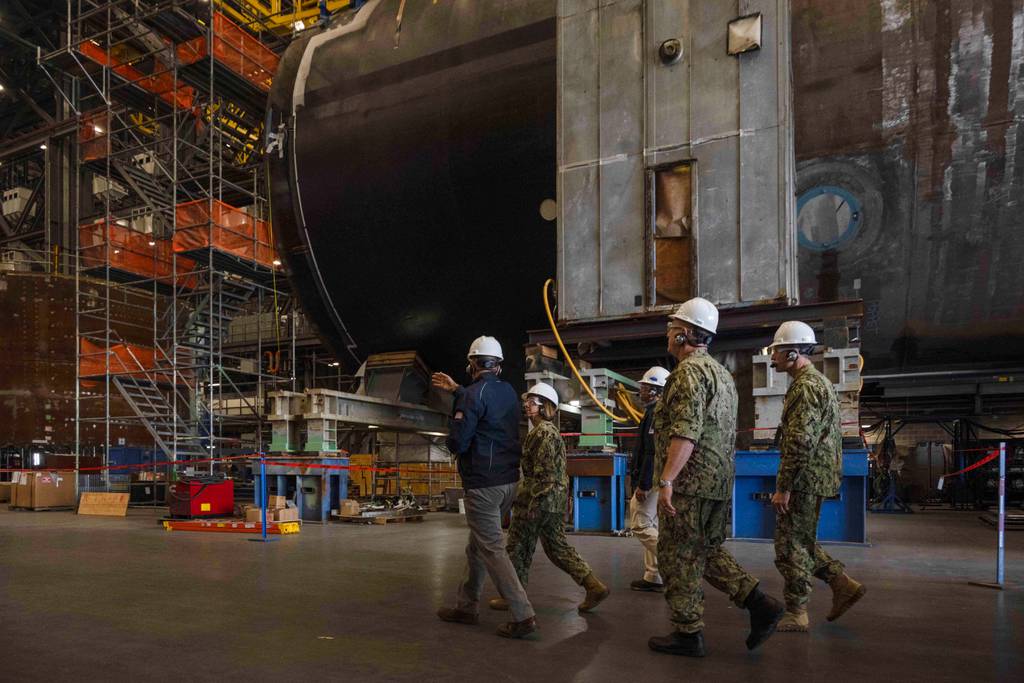
Big changes are needed to fix America’s defense industrial base and supply chain challenges.
The Department of Defense on Thursday released what it labeled a first-of-its-kind National Defense Industrial Strategy. As with most such strategies, this one falls short in providing the unafraid look at root causes and specific actions needed for rapid, measurable and sustainable improvement. But within the pages there are rays of hope and seeds for the all-important implementation plans.
The strategy does a good job describing the problem in a way that acknowledges some culpability in creating it, something previous reports from the Pentagon did not do.
Unfortunately the more blunt and useful problem characterizations that appeared in a November draft of the report are now missing in the final version. For example, in that draft report, DOD acknowledged that, in part due to its own policy in the early 1990s encouraging consolidation among defense contractors, “today’s [defense industrial base] would be challenged to provide the required capabilities at the speed and scale necessary for the U.S. military and our allies and partners to engage and prevail in a major conflict.” This statement is missing from the final version of the report.
The strategy rightly concludes the current threat environment necessitates aggressive innovation of next-generation capabilities while also continuing to upgrade and produce large volumes of existing conventional systems.
It then makes the critical connection between the problem and the budget, noting the shrinking defense share of the nation’s gross domestic product has resulted in “corresponding contractions of defense-oriented companies and a reduction of nearly two-thirds of the associated workforce.” The document also clearly points to the uncertainty of DoD funding as inhibiting domestic production capacity necessary to meet the nation’s needs.
The strategy falls short by continuing to recast old solutions as new ones rather proposing the type of corrections to current buying practices that would support industrial vibrancy. It fails to update faulty assumptions about likely attrition of equipment during conflict and neglects to lay out new, actionable and measurable solutions within DoD’s scope of control. These failures also further highlight disconnects between policy, programming, and budgeting within DOD and the inadequacy of the budget in supporting the now dangerously outdated national security and defense strategies.
The Pentagon should update these strategies, propose budgets actually sufficient to support them, focus on its core functions, modernize its resourcing and acquisition processes and prioritize procurement of both capability and capacity.
For too long, DOD has tried to pretend it can keep doing what it has been doing and doing it within budgets it knows are too low. To cover for these deficiencies, it has tried to say it can reduce the force now in exchange for increasing capability later while still meeting strategic objectives. We can clearly see those tradeoffs don’t work. Not for the force. Not for the mission. And not for industry or the nation.
DOD then compounds the fiction in this new strategy by saying it needs to “optimize defense needs in the competitive landscape” rather than supporting industry in meeting its needs with defined and funded requirements. The strategy further focuses attention on elements of the problem that are either not within its purview to solve or that it should not even be focused on fixing — such as the fictitious stigma of industrial jobs.
As for next steps, DOD should rapidly complete the referenced implementation plans to include the following four basic measures of progress.
First, is the number of companies willing to do business with DoD growing or shrinking? If efforts are having a positive impact, industry will be clamoring to work with DoD, not running from it as they are doing now.
Second, is production capacity up? There are numerous supporting measures related to material stockpiles, munitions, people eligible to work in ship yards, and outputs of air, sea, ground and space platforms.
Third, is the budget for stated industrial base priorities up or down? If the strategy is not visible in the budget, where is the disconnect?
And, finally, the ultimate measure, is the force trained, equipped and ready with the right modern capabilities and a stockpile of munitions, missiles and supplies to carry out the missions and contingencies assigned to it?
America’s creativity and capacity in producing defense capabilities is central to our national security and to the economic vitality that supports it. Yet, for decades we have witnessed, analyzed, and misunderstood the struggles that created the crises we face today. The new strategy contains useful words about the problem. Those words must be quickly put into measurable and funded actions.
Elaine McCusker is a senior fellow at the American Enterprise Institute think tank. She previously served as the Pentagon’s deputy undersecretary of defense (comptroller) as well as acting undersecretary of defense (comptroller).
- SEO Powered Content & PR Distribution. Get Amplified Today.
- PlatoData.Network Vertical Generative Ai. Empower Yourself. Access Here.
- PlatoAiStream. Web3 Intelligence. Knowledge Amplified. Access Here.
- PlatoESG. Carbon, CleanTech, Energy, Environment, Solar, Waste Management. Access Here.
- PlatoHealth. Biotech and Clinical Trials Intelligence. Access Here.
- Source: https://www.defensenews.com/opinion/2024/01/12/pentagons-industrial-strategy-describes-the-problem-not-the-solution/
- :has
- :is
- :not
- :where
- $UP
- 70
- a
- About
- acknowledged
- acquisition
- acting
- actions
- actually
- aggressive
- AIR
- also
- American
- among
- analyzed
- and
- appeared
- ARE
- AS
- assigned
- associated
- assumptions
- At
- attention
- attrition
- base
- basic
- BE
- been
- between
- both
- budget
- budgeting
- Budgets
- business
- but
- Buying
- by
- CAN
- capabilities
- capability
- Capacity
- carry
- causes
- central
- chain
- challenged
- challenges
- Changes
- clearly
- Companies
- competitive
- complete
- Comptroller
- concludes
- conflict
- connection
- consolidation
- contains
- continuing
- contractors
- control
- conventional
- Core
- Corrections
- cover
- created
- Creating
- creativity
- crises
- critical
- Current
- decades
- Defense
- defined
- Department
- department of defense
- deputy
- describes
- describing
- DID
- do
- document
- DoD
- does
- doing
- Domestic
- Dont
- down
- draft
- due
- during
- Early
- Economic
- efforts
- either
- elements
- eligible
- encouraging
- engage
- Enterprise
- Environment
- equipment
- equipped
- Even
- example
- exchange
- existing
- Face
- fails
- failures
- Falls
- faulty
- fellow
- Fiction
- final
- Finally
- Fix
- Focus
- focused
- focuses
- following
- For
- Force
- four
- from
- functions
- funded
- funding
- further
- good
- good job
- gross
- Ground
- Growing
- Have
- having
- Highlight
- hope
- House
- HTML
- HTTPS
- if
- images
- Impact
- implementation
- improvement
- in
- include
- increasing
- industrial
- industry
- Innovation
- Institute
- into
- IT
- ITS
- Job
- Jobs
- jpg
- Keep
- knows
- large
- later
- lay
- likely
- Long
- Look
- Low
- major
- MAKES
- material
- measure
- measures
- Meet
- meeting
- Military
- missiles
- missing
- Mission
- missions
- Modern
- modernize
- more
- most
- must
- nation
- National
- national security
- Nations
- nearly
- necessary
- needed
- needs
- New
- next
- next-generation
- noting
- November
- now
- number
- numerous
- objectives
- of
- Old
- on
- ONE
- ones
- or
- our
- out
- outputs
- own
- pages
- part
- partners
- pentagon
- People
- plans
- Platforms
- plato
- Plato Data Intelligence
- PlatoData
- points
- policy
- positive
- practices
- previously
- Prioritize
- Problem
- processes
- procurement
- produce
- producing
- Product
- Production
- Programming
- Progress
- propose
- proposing
- provide
- providing
- put
- quickly
- rapid
- rapidly
- rather
- ready
- reduce
- reduction
- related
- released
- report
- required
- Requirements
- resulted
- right
- root
- running
- s
- say
- saying
- Scale
- scope
- SEA
- security
- see
- seeds
- senior
- served
- Share
- she
- ship
- Short
- should
- solution
- Solutions
- SOLVE
- some
- something
- Space
- specific
- speed
- stated
- Statement
- Steps
- Still
- Strategic
- strategies
- Strategy
- Struggles
- such
- sufficient
- supplies
- supply
- supply chain
- Supply Chain Challenges
- support
- Supporting
- Supports
- sustainable
- Systems
- tank
- than
- that
- The
- Them
- then
- There.
- These
- they
- think
- think tank
- this
- those
- threat
- thursday
- to
- today
- too
- trained
- tried
- two-thirds
- type
- u.s.
- ultimate
- Uncertainty
- Update
- upgrade
- version
- visible
- Vitality
- volumes
- Way..
- we
- WELL
- What
- while
- will
- willing
- with
- within
- witnessed
- words
- Work
- Workforce
- would
- yet
- zephyrnet












